Federated Data Governance: Principles, Benefits, Setup in 2024
Share this article
Federated data governance is a concept where you can define data governance standards centrally, while allowing the local domain teams to choose how they execute these standards.
Federated data governance differs from centralized data governance, where a central team controls all organizational data, reducing autonomy and interoperability across data teams.
See How Atlan Simplifies Data Governance – Start Product Tour
Data architecture approaches, such as the data mesh, use federated data governance to balance autonomy with overall data quality and consistency. According to Adam Bellemare, author of ‘Building an Event-Driven Data Mesh’, federated governance allows you to sort out the decisions that should remain at the local level from those that must be made globally for all data domains.
This article will explore what federated data governance entails, its benefits, examples, and how it’s implemented.
Table of Contents #
- What is federated data governance?
- Difference between federated and centralized data governance
- Benefits of federated data governance
- How to implement federated data governance?
- Federated data governance: The key to democratizing data
- Related reads
What is federated data governance? #
Federated data governance is a concept where you can define data governance standards centrally, while allowing the local domain teams to choose how they execute these standards.
Here’s how Prukalpa Sankar, co-founder at Atlan, explains federated data governance:
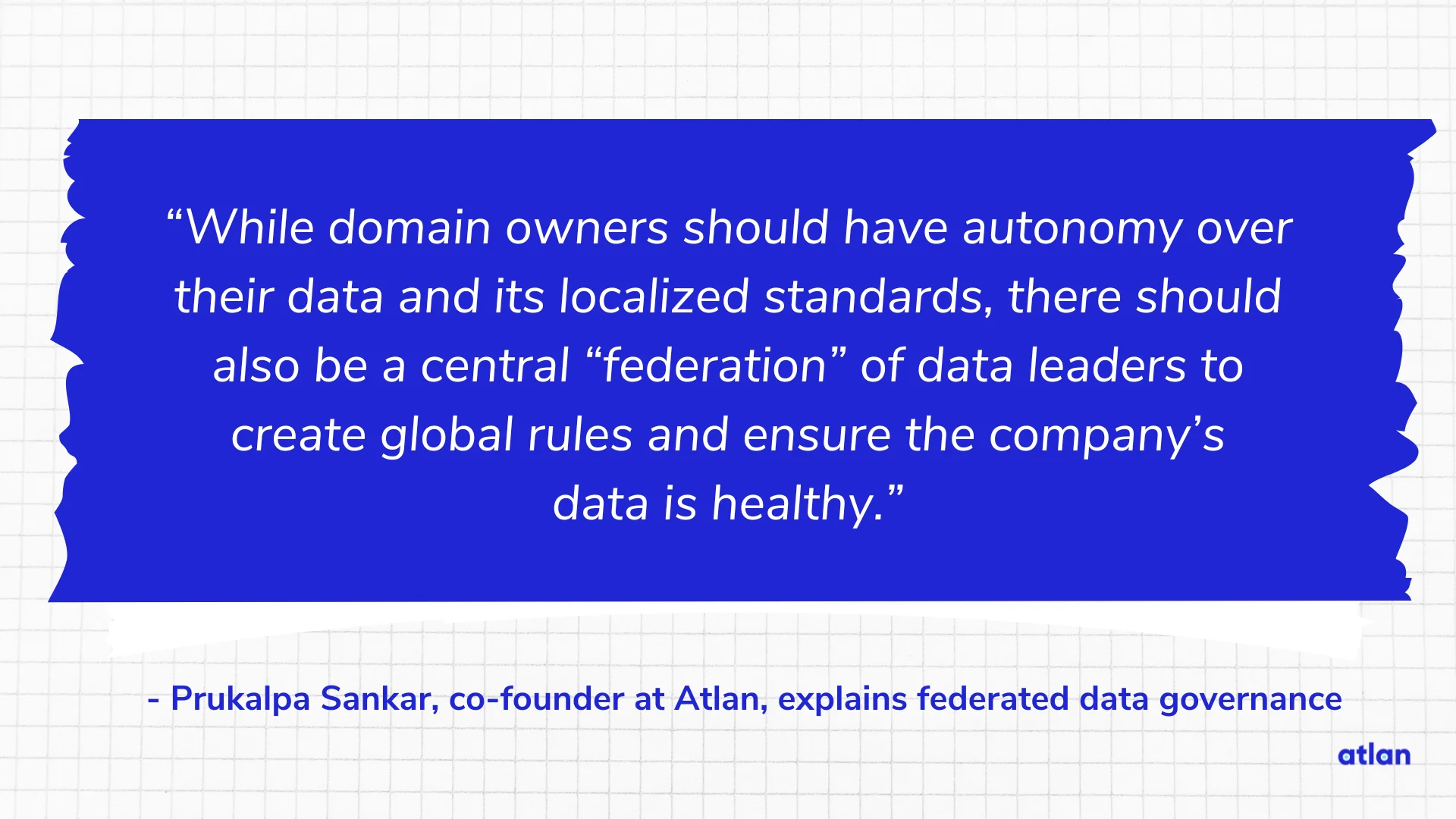
What is federated data governance - Source: Atlan.
Ex-Thoughtworks consultant Zhamak Dehghani calls it a “decision-making model led by the federation of domain data product owners and data platform product owners, with autonomy and domain-local decision-making power, while creating and adhering to a set of global rules - rules applied to all data products and their interfaces - to ensure a healthy and interoperable ecosystem.”
Implementing federated governance will require:
- A centralized team: This team is tasked with defining standardized data governance policies — authentication processes validating user identities, authorization protocols for appropriate access rights, etc. This team ensures that data products and datasets can be shared and reused.
- Domain teams: These are often lines of business teams. Domain teams are accountable for operational data governance tasks within their specific data domain, such as mapping, documentation, and quality management. In other words, they’re responsible for the governance of their domain data. Each domain team has the autonomy and resources to execute the standards defined by the centralized team.
Next, let’s explore the concept of federated data governance further with some examples.
Federated data governance: Examples #
Ideally, you should globalize aspects common to all domains, such as security, compliance, regulation, and decisions promoting interoperability.
For example, the policies and standards for data access controls and permissions must be set up globally. However, determining specific access levels and permissions for different teams can be handled locally, depending on their roles and responsibilities.
Another example is that of data quality. While data quality metrics should be defined and standardized globally, data cleansing and validation processes to address domain-specific data quality issues can be set up locally.
Let’s delve deeper into the concept of federated data governance by understanding how it’s different from a centralized approach to data governance.
What is the difference between federated and centralized data governance? #
The distinction between federated and centralized data governance lies in how each approach handles data access, accountability, and use.
Centralized data governance is rigid, top-down, and relies on a central team to handle governance activities for the entire organization. This makes it difficult to scale, adapt, and collaborate.
Meanwhile, federated data governance is a flexible, scalable, and democratic approach where a central team oversees global rules, providing domains with adequate autonomy to oversee local governance. However, this approach can be complex and lead to data silos, duplication, redundancy, and more.
Here’s a table summarizing the differences.
| Aspect | Centralized data governance | Federated data governance |
|---|---|---|
| Definition | Top-down, one-size-fits-all approach to data governance where a central team is responsible and held accountable for ensuring data security, privacy, integrity, and regulatory compliance | Bottom-up, scalable approach to data governance where a central team creates global rules, but each domain has the autonomy to adapt to local conditions |
| Purpose | Focused on setting up data controls and restrictions | Focused on enabling nimble, lean data governance with less bureaucracy and restrictions |
| Benefits | Low complexity in managing and maintaining data, easier governance with only a single set of policies | Easy scalability, high interoperability, efficient data sharing, improved collaboration, data democratization |
| Challenges | Low scalability and interoperability, limited data sharing and collaboration | Greater complexity as the numerous domains must coordinate, complex data governance as multiple policies may exist |
| Central team responsibilities | 1. Owns activities related to data governance and is held accountable 2. Defines and enforces data standards, policies, and usage guidelines 2. Controls access 3. Oversees compliance and reporting | Establishes and oversees global rules and standards for data governance |
| Domain team responsibilities | Works under the central team and adheres to the standards set by the central team | 1. Works with the central team to ensure proper governance 2. Owns activities related to local data governance (within the domain) 3. Is accountable for monitoring data access, consumption, and use within the domain 4. Governs data access, quality, and compliance with the global data standards |
| Benefits | Slower and more rigid | Faster and more flexible |
| Best suited for | Small businesses with non-complex data needs | Large businesses with rapidly scaling teams and data consumers |
Now, let’s explore the benefits of adopting federated data governance.
What are the benefits of federated data governance? #
Federated data governance brings organizations closer to data democratization without compromising security, privacy, or integrity. It’s ideal for modern, cloud-based enterprises that generate large amounts of data and must move fast.
Here are some of the key benefits of federated data governance:
- Enabling data democratization
- Activating the data mesh (and ensuring its successful implementation)
- Supporting faster decision-making and implementation
- Ensuring consistent metadata management across domains
- Implementing customized policies
- Establishing clear ownership and accountability
- Ensuring security and compliance at scale
Driving self-service, trust, and BI use cases with federated data governance: An example #
Consider Autodesk, a global leader in design and engineering software and services. Despite adopting modern tools like Snowflake to speed up data analytics and business intelligence, the company needed help scaling its use cases.
By 2021, Autodesk faced a data backlog larger than ever before, with a team too small to handle it independently. So, the company decided to switch to federated data governance.
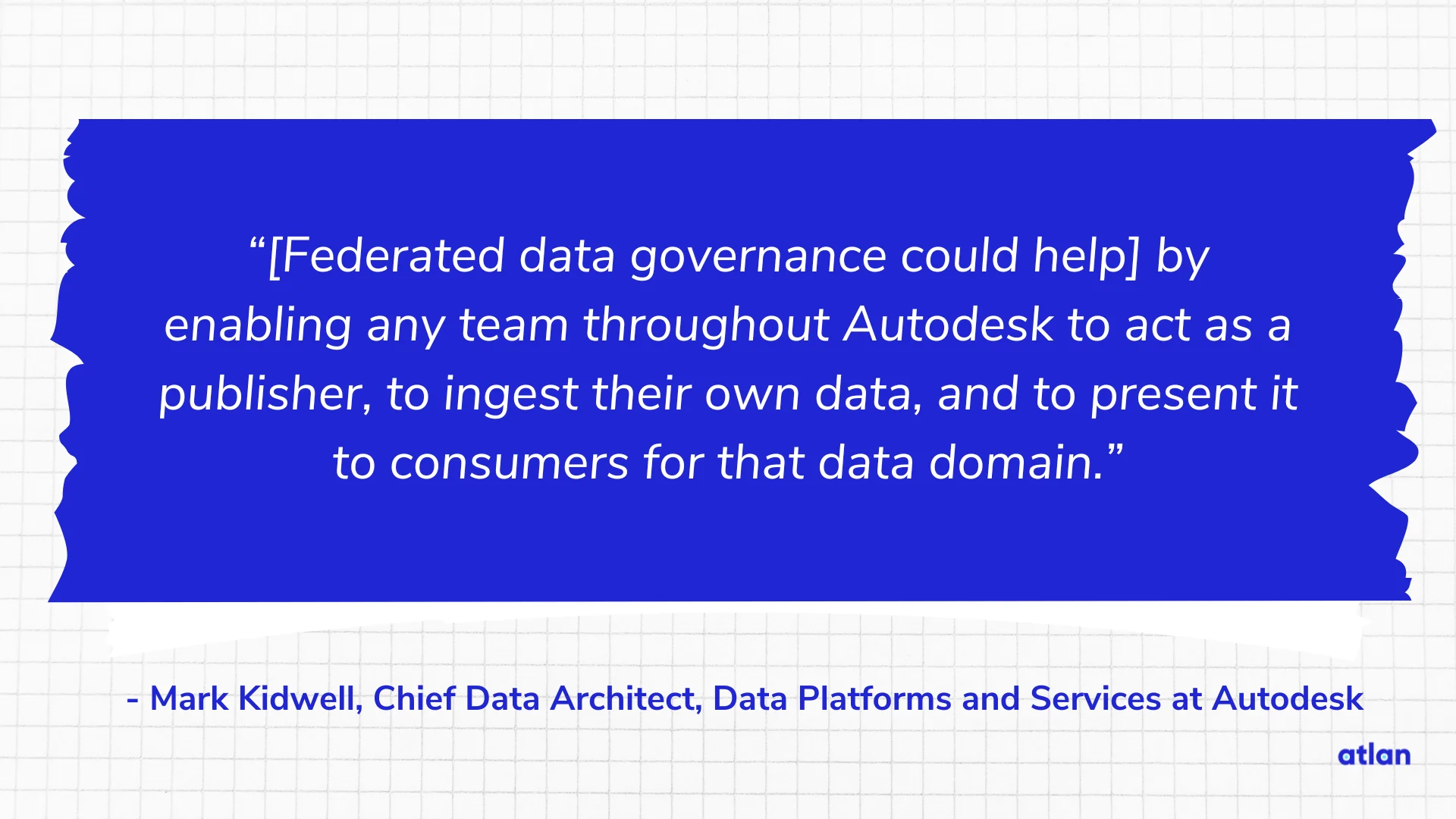
Benefits of federated data governance - Source: Mark Kidwell, Chief Data Architect, Data Platforms and Services at Autodesk.
They now have 60 domain teams with complete visibility into the consumption of their data products. Additionally, their consumers have a self-service interface to discover, understand, and rely on their data products.
How to implement federated data governance: 8 steps to follow #
Here are eight steps to consider when implementing federated data governance:
- Define data domain owners and responsibilities
- Set up a central federation
- Establish global consistency
- Choose a modern data catalog
- Identify success metrics
- Ensure cross-domain collaboration and communication
- Offer continuous training and education
- Encourage a culture of continuous learning
Let’s delve into the specifics.
1. Define data domain owners and responsibilities #
Data domain owners are accountable for local data management and compliance. So, identify and establish their responsibilities regarding data security, access control, data lifecycle management, compliance, data use for decision-making, and documentation.
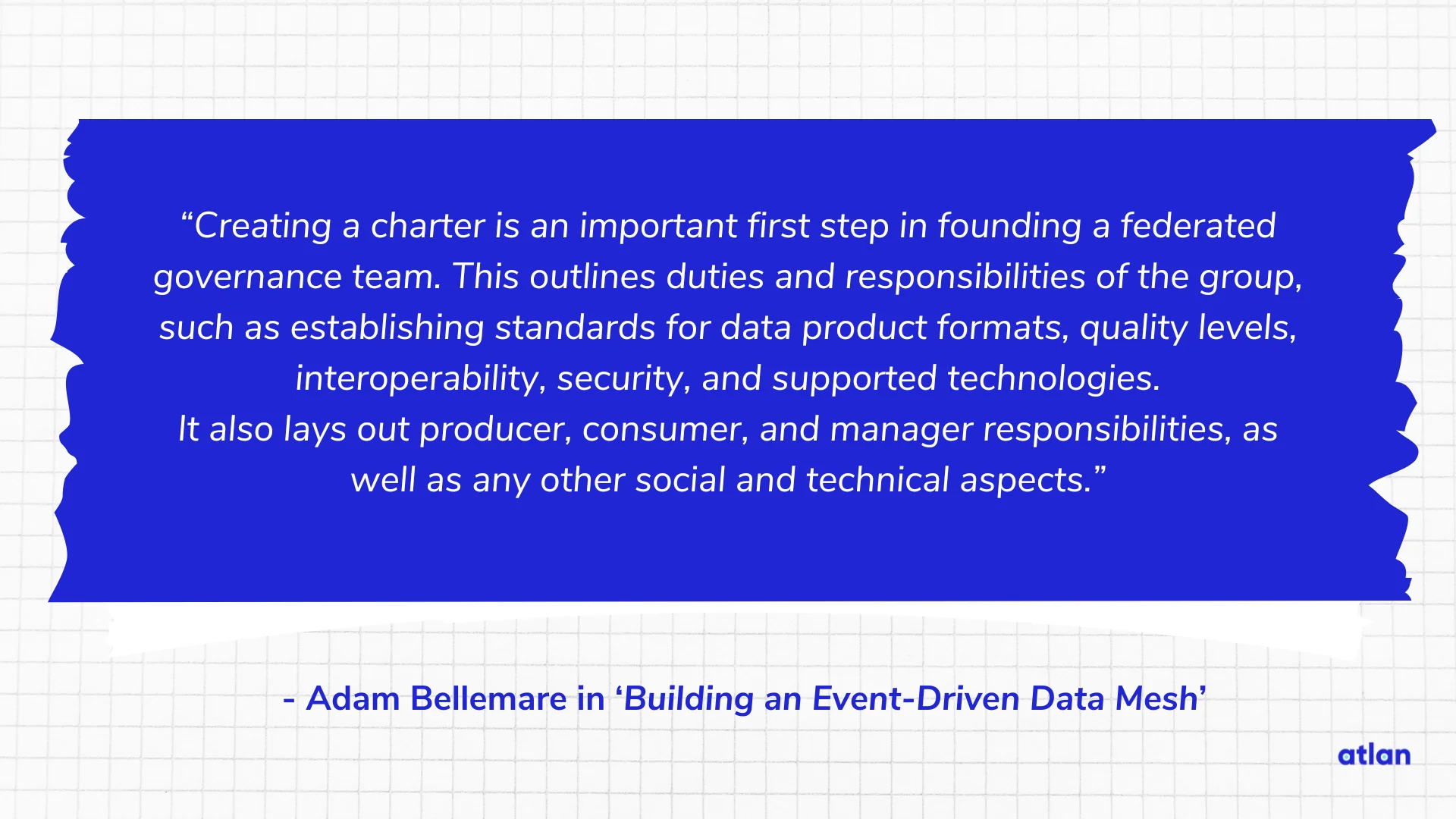
Define data domain owners and responsibilities - Source: Adam Bellemare in Building an Event-Driven Data Mesh.
Also, set up clear structures for creating and documenting data domains. This is crucial because ambiguity in ownership and accountability is a common challenge in federated models.
Also, read → Data governance roles and responsibilities
2. Set up a central federation #
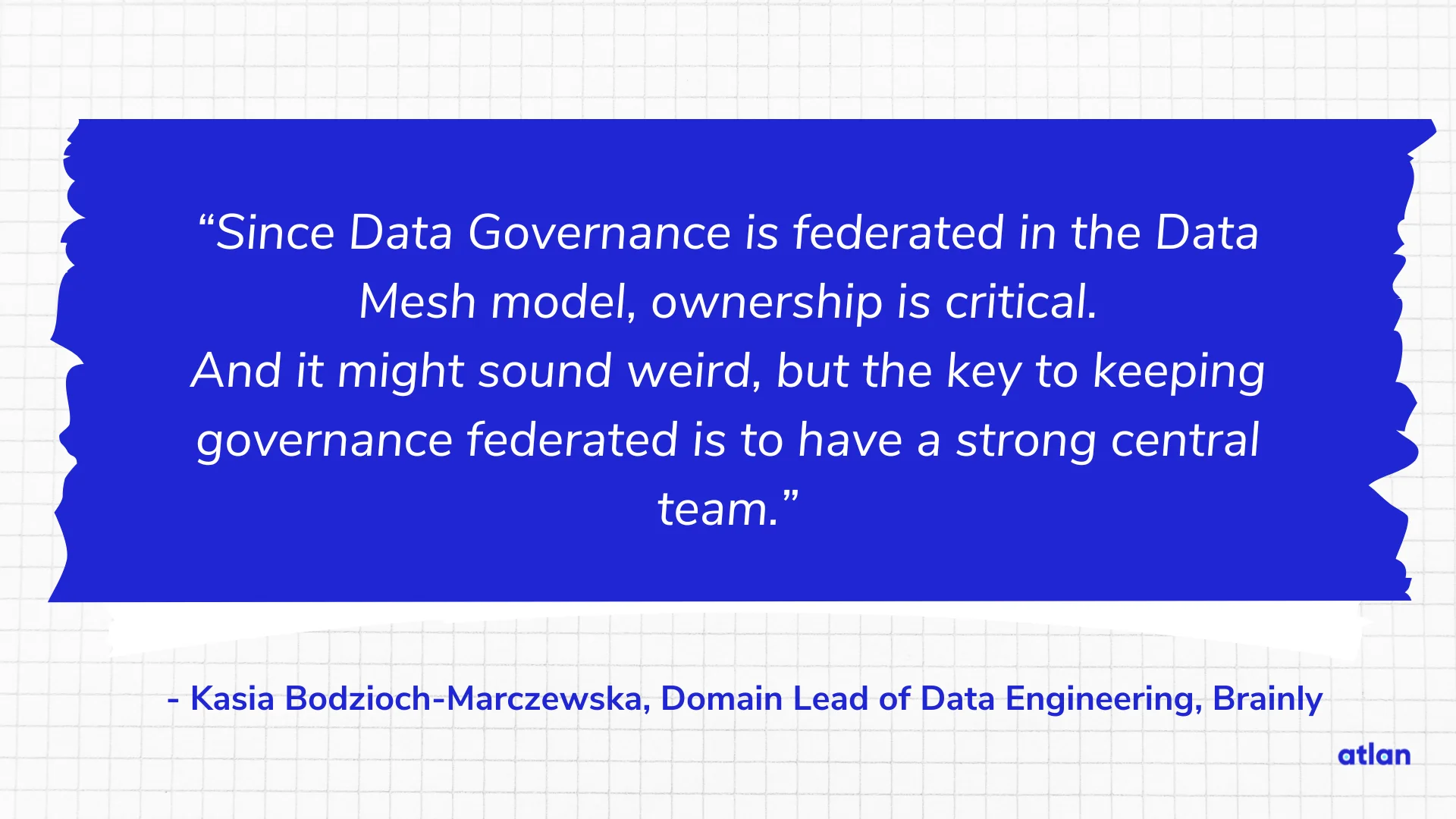
Set up a central federation - Source: Kasia Bodzioch-Marczewska, Domain Lead of Data Engineering, Brainly.
Build a central federation of data producers, stewards, and other relevant stakeholders. This group is responsible for ensuring that the rules are being followed and that an enterprise’s data assets are healthy.
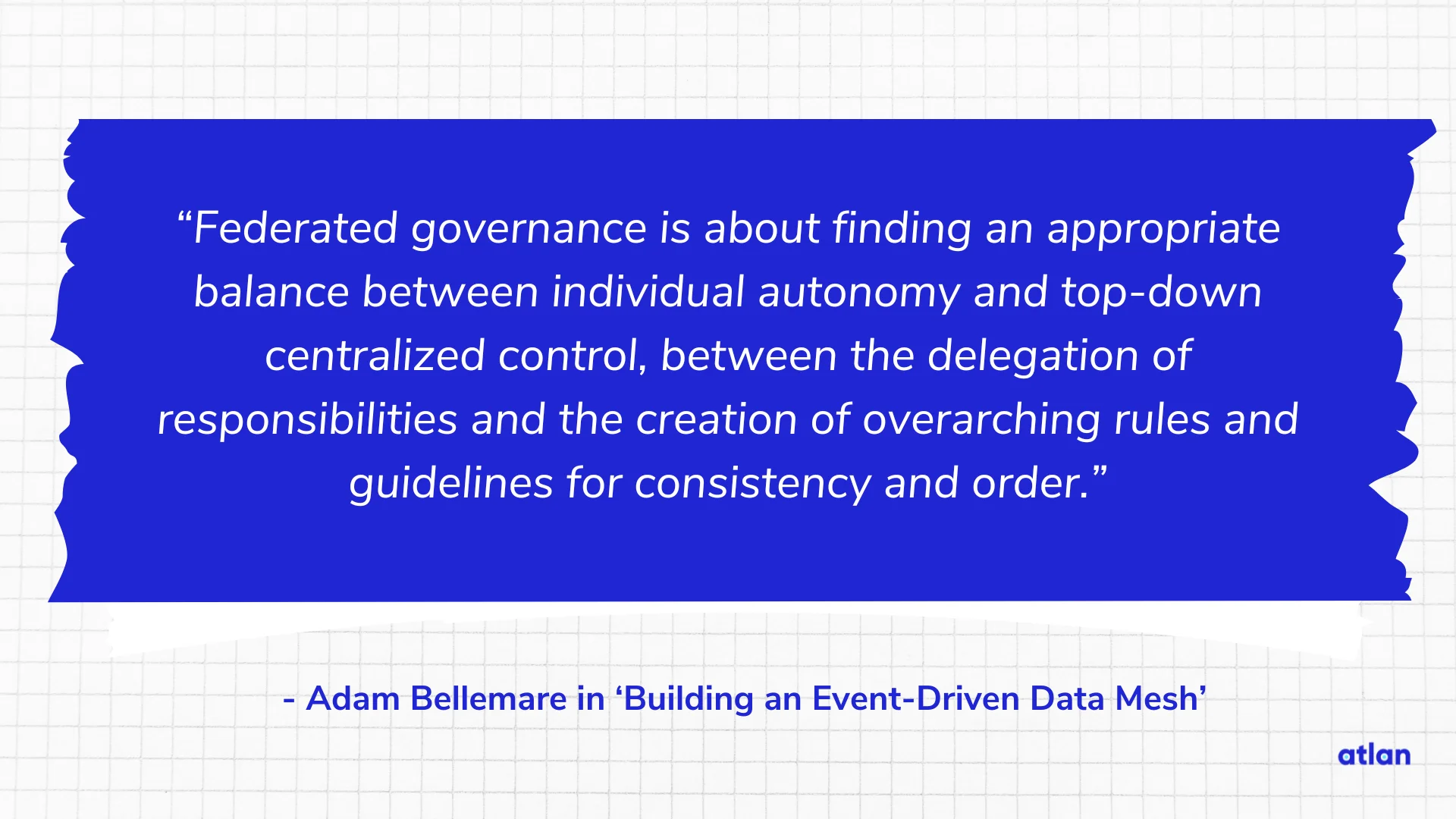
Building an Event-Driven Data Mesh - Source: Adam Bellemare in Building an Event-Driven Data Mesh.
3. Establish global consistency #
Establishing global consistency in rules, policies, and business glossaries is crucial to ensure everyone understands and adheres to the applicable regulations.
This plays a central role when introducing new tools, languages, standards, and technologies within domains. With global consistency, you get a unified approach, eliminating chaos, promoting transparency, and reducing the risk of errors or misinterpretations.
Also, read → Data consistency 101
4. Choose a modern data catalog #
The cornerstone of federated data governance is a modern data catalog with active metadata management. Such a catalog can connect with all the tools in your data stack and house all of your metadata in a central repository.
With active metadata management, the catalog can facilitate bidirectional metadata sync across your data stack using open APIs. This integrates context seamlessly, for example, from Snowflake to Looker, Looker to Slack, Slack to Jira, and Jira back to Snowflake.
As a result, your metadata is constantly updated, facilitating better data discovery, understanding, and use.
Modern data catalogs also support automation, reducing grunt work and implementing governance at scale.
Consider the case of Brainly, the world’s most popular education app. With hundreds of millions of students, educators, and general users and a presence in 35 countries, Brainly generates a lot of data.
Brainly implemented a data mesh to organize work better and foster full ownership and stewardship of their data. Finding and setting up the right data catalog was crucial to the success of the data mesh as it could help eliminate the team-to-team collaboration friction inherent to the mesh approach.
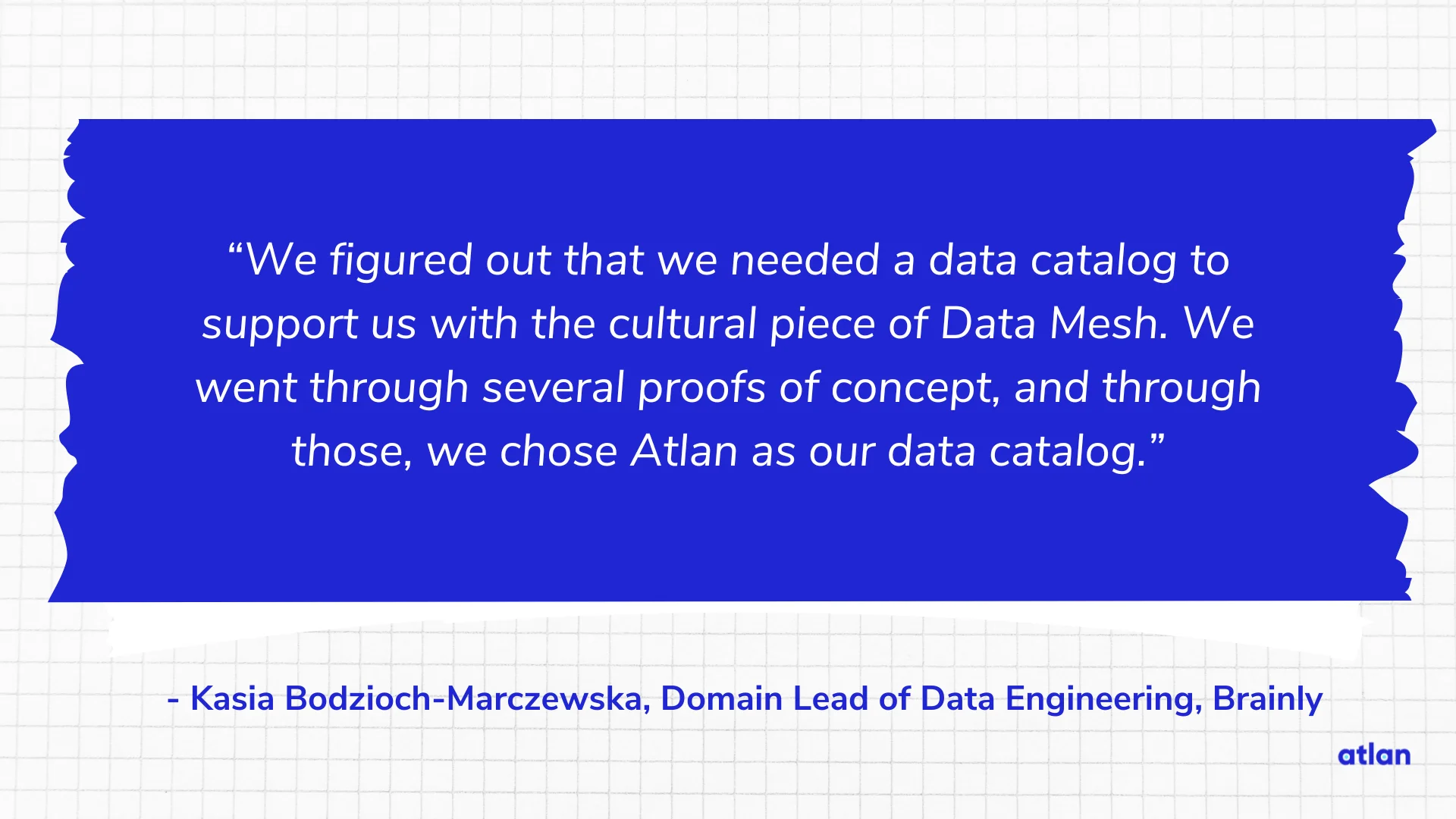
Choose a modern data catalog - Source: Kasia Bodzioch-Marczewska, Domain Lead of Data Engineering, Brainly.
Dive deeper → Modern data catalogs: What they are, how they’ve changed, where they’re going
5. Identify metrics #
As with any business initiative, you must measure the effectiveness of a federated data governance program to ensure that it’s consistently delivering business value. So, identify metrics for data and metadata quality, governance, and compliance and track them using the data catalog.
For instance, the ROI in data quality can be measured by identifying the cost of poor data quality and determining success factors, such as cost savings, revenue generation, time to value, and customer satisfaction.
Dive deeper → How to drive business value with data governance
6. Ensure collaboration and communication #
Besides defining the roles and responsibilities of the central group and domain teams, establishing communication points is equally crucial to the success of federated data governance.
That’s why domain owners, stewards, and other relevant stakeholders must communicate through regular meetings, forums, and workshops.
For instance, domain owners can use forums to exchange ideas, best practices, and lessons learned, fostering a culture of continuous improvement and innovation within each domain. Meanwhile, the central federation and domain owners can meet for strategic planning, updates, issue resolution, and alignment so that all teams are working towards common goals and objectives.
7. Offer training programs #
Offer training programs, awareness workshops, and other ways of educating all data practitioners and users across the enterprise on federated data governance principles, policies, procedures, and more.
For instance, you can develop structured training programs tailored to different organizational roles. You can also conduct workshops, including interactive sessions, case studies, and real-life examples to illustrate the importance and benefits of federated governance.
You can also draw inspiration from digital financial services company Zip and gamify governance. Zip launched the internal business glossary with an “Easter Egg Hunt”.
Zip’s data consumers had to locate jargon, slang, or colloquialisms (specific to Zip) hidden in their new business glossary. Zip expanded the gamification strategy by running more competitions, rewarding:
- Data consumers who used the data catalog (directly, or indirectly through Slack and Tableau) to search for terms and definitions
- The most prolific contributors to asset and term definitions in the business glossary
Also, read → 5 popular data governance certifications and training in 2024
8. Encourage a culture of continuous learning #
Businesses that foster a culture of continuous improvement truly enhance the outcomes of their governance initiatives.
You can start by establishing platforms and forums for internal knowledge sharing. Encourage data domain owners and experienced data practitioners to share their insights, best practices, success stories, and lessons learned.
Look at Grainger, for instance. The industrial supplies and equipment provider created a virtuous cycle of data literacy, inspiring more subject matter experts to share their knowledge. In 2023, the company won Atlan’s Data Culture Award for its modern data team.
The award commended Grainger for “building champions across their organization, and a culture of people that care about documentation.”
So, explore ways to foster a culture of curiosity, exploration, and continuous learning where everyone is encouraged to ask questions, seek knowledge, and experiment with new ideas.
Also, read → How to improve data literacy in 2024
Federated data governance: The key to democratizing data #
Federated data governance offers a flexible and scalable approach for organizations to manage data effectively while empowering domain teams with autonomy. By striking a balance between global standards and local setups, you can ensure data democratization, faster decision-making, and improved collaboration.
Implementing federated data governance requires clear roles, effective communication, global consistency, continuous training, and a culture of continuous learning. Above all, it warrants a modern data catalog with active metadata management to reduce friction between the various domains and ensure global consistency, transparency, and trust.
Federated Data Governance: Related reads #
- Data Governance in Action: Community-Centered and Personalized
- Data Governance Framework — Examples, Templates, Standards, Best practices & How to Create One?
- Data Governance Tools: Importance, Key Capabilities, Trends, and Deployment Options
- Data Governance Tools Comparison: How to Select the Best
- Data Governance Tools Cost: What’s The Actual Price?
- Data Governance Process: Why Your Business Can’t Succeed Without It
- Data Governance and Compliance: Act of Checks & Balances
- Data Governance vs Data Compliance: Nah, They Aren’t The Same!
- Data Compliance Management: Concept, Components, Getting Started
- Data Governance for AI: Challenges & Best Practices
- A Guide to Gartner Data Governance Research: Market Guides, Hype Cycles, and Peer Reviews
- Gartner Data Governance Maturity Model: What It Is, How It Works
- Data Governance Roles and Responsibilities: A Round-Up
- Data Governance in Banking: Benefits, Implementation, Challenges, and Best Practices
- Data Governance Maturity Model: A Roadmap to Optimizing Your Data Initiatives and Driving Business Value
- Open Source Data Governance - 7 Best Tools to Consider in 2024
- Federated Data Governance: Principles, Benefits, Setup
- Data Governance Committee 101: When Do You Need One?
- Data Governance for Healthcare: Challenges, Benefits, Core Capabilities, and Implementation
- Data Governance in Hospitality: Challenges, Benefits, Core Capabilities, and Implementation
- 10 Steps to Achieve HIPAA Compliance With Data Governance
- Snowflake Data Governance — Features, Frameworks & Best practices
- Data Governance Policy: Examples, Templates & How to Write One
- 7 Best Practices for Data Governance to Follow in 2024
- Benefits of Data Governance: 4 Ways It Helps Build Great Data Teams
- Key Objectives of Data Governance: How Should You Think About Them?
- The 3 Principles of Data Governance: Pillars of a Modern Data Culture
Share this article











